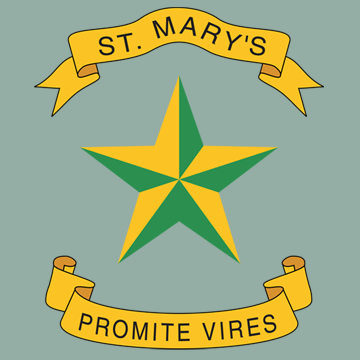Memories
Recollections of a Different Era
I'm neither old enough nor famous enough to be writing memoirs. But the world has changed around us rather rapidly in the 50 years since I was in school. Today as I double-click an mp4 to play a movie, and beam music from a smartphone to the stereo, or just bring up a spreadsheet, it's entertaining to recall the way things used to be. How far do we have to rewind to go back to the days before the Internet. Before Cut and Paste. Before the Backspace key — have they canonized the inventor of Backspace yet? Before computers. Before 4-function calculators. Before xerox machines. Before cassette tape recorders. When Armstrong landed on the moon, the best we in Abu could do was to listen to the commentaries on shortwave radio, and we'd have had to be in the Brothers' quarters to do that. Here are a few random tidbits of our lifestyle in school in the 1960s-70s, some technological, some not. Perhaps some of these practices still survive today. For those who lived through this, a few memories and chuckles. To those who didn't, my generation offers our sympathies.
Dinner. My first dinner at SMS was a revelation. We'd sat at our tables, by class. The manager came by. “Who are the meat-wallas?” (non-vegetarians). Hands were raised. “Who are the subji-wallas?” Bearers promptly delivered a cutlet of appropriate content. “Are you getting an egg?” “What?” We subscribed to an egg each morning, or to two eggs, some to a cup of milk. Subscriptions were painted in hieroglyphic code on the frame of the dining table. Oil paint. Markers didn't exist.
Speaking of markers, the dhobi needed to tell Ajay's clothes from Bob's. So before we left for school, moms would buy a bottle of “marking ink,” and a “pen-holder” (really a nib-holder: a thin dowel to which you could attach a nib), and literally scratched our names on below the collar. If they made the mistake of doing it on a single sheet of cloth, as on vests, the ink would eat through the fabric by the end of the year. Some used woven tags, others hand-embroidered initials; either way this operation started a month before departure. Have you hugged your mom recently?
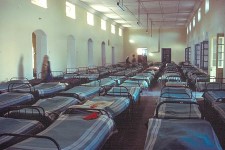 Dorms. About 150 kids slept together in a dormitory, and two or three incandescent 100-watt bulbs lit the entire place. We'd have perhaps 45 minutes of unwind time before lights out each night. Some would read, others would gather around a teacher who'd make up a good story about Banshee cats or other Irish yarns. If a nun was in charge, it would be a Bible story, or we'd have our attention directed to the classmate du jour. Either a compulsive delinquent in need of reform, or someone like Patrick McMahon, who polished his shoes, faithfully tidied his bed in the morning and generally led an exemplary life. Sometimes we were required to be silent in the dorm, but the staff got more liberal about that over the years.
Dorms. About 150 kids slept together in a dormitory, and two or three incandescent 100-watt bulbs lit the entire place. We'd have perhaps 45 minutes of unwind time before lights out each night. Some would read, others would gather around a teacher who'd make up a good story about Banshee cats or other Irish yarns. If a nun was in charge, it would be a Bible story, or we'd have our attention directed to the classmate du jour. Either a compulsive delinquent in need of reform, or someone like Patrick McMahon, who polished his shoes, faithfully tidied his bed in the morning and generally led an exemplary life. Sometimes we were required to be silent in the dorm, but the staff got more liberal about that over the years.
How did we get naughty? We'd talk in the dorm. We'd go for a walk out of bounds, steal the peaches from Mr Verghese's garden, climb the jambool tree, bunk baths, and such.
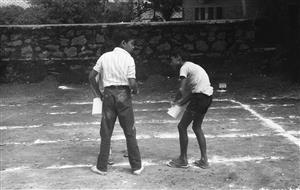 Chalking fields. One of the duties we performed as “Crusaders” (the do-good club for the younger crowd, before we were eligible for the Legion of Mary) was chalking the fields — marking the boundaries and D of the hockey fields. One part of the job was to use a pick-axe to freshen the ~3 cm deep trenches in the soil that served as boundaries. The second part was to fill the trench with chalk. Real chalk would be a budget item. But the bakery behind the school ejected a fair bit of ash from the wood fires. We'd gather up the stuff in a steel pail. Novices like me would drop great gobs of ash in one spot. The experts would stand straddling the trench, lean over and let the ash dribble between their fingers at a steady rate for a uniform line.
Chalking fields. One of the duties we performed as “Crusaders” (the do-good club for the younger crowd, before we were eligible for the Legion of Mary) was chalking the fields — marking the boundaries and D of the hockey fields. One part of the job was to use a pick-axe to freshen the ~3 cm deep trenches in the soil that served as boundaries. The second part was to fill the trench with chalk. Real chalk would be a budget item. But the bakery behind the school ejected a fair bit of ash from the wood fires. We'd gather up the stuff in a steel pail. Novices like me would drop great gobs of ash in one spot. The experts would stand straddling the trench, lean over and let the ash dribble between their fingers at a steady rate for a uniform line.
One day in 1967 while we were chalking the volleyball courts behind the main building, a guy I shall call “L” picked up a stray date palm, straddled it and trailed it behind him, and galloped around, calling it his horse. Good idea! I picked one up too. L didn't think highly of sharing his mounted status, so he planted his foot on my trail and I came crashing down. This was one of the grandpa palms, with long hard thorns around the base. An inch-long section pierced my calf. Hospi Sas patched it over. A few times. It stayed there 6 months until my mum came up for Sports Day, enquired about this festering wound, spoke to Hospi Sas and arranged for thorough tests. The doc came to school every Sunday. He ordered me in to the hospital in town for an “operation.” Zarryl was an outpatient in the hospital that day too. The doc asked him to stick his finger into the open incision to stem the bleeding — apparently no medical quals or sterile equipment were needed. Z fainted. We both survived. I still have a 3 cm scar from that operation. Z's troubles may take even longer … “All the perfumes of Arabia will not sweeten this little hand” [Lady Macbeth].
Monsoons. Things got dreary during the monsoons. The mist came by every morning and dampened everything, starting with our spirits. The spray from the rain turned the stone corridor floors quite slippery. We played Four Corners in the little square alcoves in the main building. We strummed guitars in the dorms, and listened to music on Keith Angelo's cassette player. Or we'd get properly wet, swimming in School Lake. Br Kelly gathered the rainwater coming down the eavestroughs, filtered it, and it became the distilled water in the chemistry lab. There was a rain gauge in the yard in front of the Brothers' quarters. And a complete Stevenson screen with a Six's thermometer and barometer. A boy was assigned to check rainfall and temperature readings each morning before class. The rainwater in the below-ground collector had to be poured into a measuring cylinder, each cylinder being half an inch. Avinash D'Mello got excited one morning because he measured 4 inches/100 mm overnight. Where I live now, that would be a quarter of a year's precipitation.
The bell. When I joined school the bell was outside the big dorm, by the Tuck Shop. When the Rice Wing was put up, the bell was moved to the 1st floor of that building. How many ways are there to ring a bell? To most of us, it was a matter of a few thoughtless wallops. Band master Mr H J Ludwig introduced a different way. Leisurely and regular: ding, ding … pause … ding, ding … pause … ding, ding … pause … ding. He hypothesized that the sound waves reinforced each other and resonated as they spread into the jungle. Baloney, but it certainly sounded more becoming of an institution of learning. About 1972 the bell developed a crack. It was several months before a replacement was installed. Till then a steel pipe was suspended in the same place, and even Mr Ludwig would have been found it difficult to distinguish the sounds.
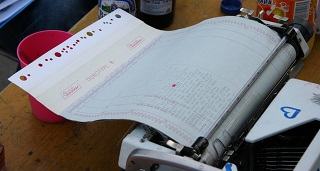 The copier. How did they make copies of handouts in the days before the Xerox machine? It was in Abu that I was introduced to cyclostyling. The basic idea was to create a stencil out of a thin sheet of wax, wrap it around a drum with some gooey black ink inside, and run paper over the oozing stencil one sheet at a time. The stencils were floppy enough that they could scroll through a typewriter, with the ribbon disabled so the sharp type element cut a clean impression. The wax sheet and its backing were held together by a card at the top with a distinctive pattern of holes in it. If there were too many typos, or the stencil got torn or creased, the page would have to be re-typed. That was the easy part. The difficult part was that the stencil assembly was expensive and not something to trash indiscriminately. For the same reason they'd probably type up a rough copy of the page first to check margins and pagination.
The copier. How did they make copies of handouts in the days before the Xerox machine? It was in Abu that I was introduced to cyclostyling. The basic idea was to create a stencil out of a thin sheet of wax, wrap it around a drum with some gooey black ink inside, and run paper over the oozing stencil one sheet at a time. The stencils were floppy enough that they could scroll through a typewriter, with the ribbon disabled so the sharp type element cut a clean impression. The wax sheet and its backing were held together by a card at the top with a distinctive pattern of holes in it. If there were too many typos, or the stencil got torn or creased, the page would have to be re-typed. That was the easy part. The difficult part was that the stencil assembly was expensive and not something to trash indiscriminately. For the same reason they'd probably type up a rough copy of the page first to check margins and pagination.
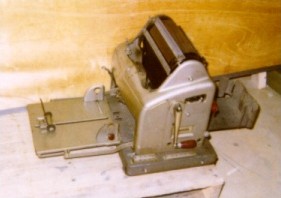 To run the copies, the stencil would first have to be registered on the Gestetner cyclostyling machine, the odd set of holes in the card placed over a corresponding set of odd pins on the machine. Ink was squeezed out of a huge toothpaste-type tube. Then the fun would start, each copy generated by cranking the machine by hand. A special paper was required, coarse and absorbent. If the stencil happened to crease or seize halfway through the job, it would be back to the typewriter to make a new one. So you learnt not to crank too fast. Specialists like Br Foran could create duplex copies. But it took the devotion and genius of Br McCarthy to work out the folds to produce 4-up booklets. Br Pinto printed notes on geography, with detailed maps. Later, at St Xavier's College in Bombay, Fr Comin handed out elaborate Calculus notes with mathematical symbols, dutifully typed and cyclostyled each year by Mr Freitas. If you ever received cyclostyled handouts, you need to appreciate the enormous effort that went into them. Have you hugged your teacher recently?
To run the copies, the stencil would first have to be registered on the Gestetner cyclostyling machine, the odd set of holes in the card placed over a corresponding set of odd pins on the machine. Ink was squeezed out of a huge toothpaste-type tube. Then the fun would start, each copy generated by cranking the machine by hand. A special paper was required, coarse and absorbent. If the stencil happened to crease or seize halfway through the job, it would be back to the typewriter to make a new one. So you learnt not to crank too fast. Specialists like Br Foran could create duplex copies. But it took the devotion and genius of Br McCarthy to work out the folds to produce 4-up booklets. Br Pinto printed notes on geography, with detailed maps. Later, at St Xavier's College in Bombay, Fr Comin handed out elaborate Calculus notes with mathematical symbols, dutifully typed and cyclostyled each year by Mr Freitas. If you ever received cyclostyled handouts, you need to appreciate the enormous effort that went into them. Have you hugged your teacher recently?
Using a mouse to crank up the number of copies on a print menu is for philistines.
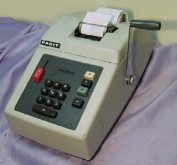 Calculators. Remember those pink cards (80% and over), blue cards (60-80%), white cards (40-60%) and yellow/purple cards (below 40%) that we received ceremoniously at Proclamations after periodic tests? That was the side we saw. From the teachers' point of view, a recurring nightmare was adding up each student's marks, and dividing by the number of subjects (an unholy integer like 17), to get a percentage. Br Judge deputized the addition task to us over a few tests in 1971. The incentive was that we'd get to use his high-tech toy, a Facit adding machine. This worked on a crank too. To add 5 and 16, you'd type 5, pull the crank down, type 16, crank, hit the + button, crank once again, and voila, there was the answer. The Facit could only add and subtract; division by 17 was still a manual task. Of course we wrecked the machine by the third exam, but it was just another half-decade before the electronic calculator took over this business, and even did the division by 17.
Calculators. Remember those pink cards (80% and over), blue cards (60-80%), white cards (40-60%) and yellow/purple cards (below 40%) that we received ceremoniously at Proclamations after periodic tests? That was the side we saw. From the teachers' point of view, a recurring nightmare was adding up each student's marks, and dividing by the number of subjects (an unholy integer like 17), to get a percentage. Br Judge deputized the addition task to us over a few tests in 1971. The incentive was that we'd get to use his high-tech toy, a Facit adding machine. This worked on a crank too. To add 5 and 16, you'd type 5, pull the crank down, type 16, crank, hit the + button, crank once again, and voila, there was the answer. The Facit could only add and subtract; division by 17 was still a manual task. Of course we wrecked the machine by the third exam, but it was just another half-decade before the electronic calculator took over this business, and even did the division by 17.
My dad had a different pocket-sized adding device. It's difficult to explain its intricate workings without writing a user's manual. There were columns of metal teeth, one column 0-9 for the units place, another for the tens place, hundreds, etc. To add 5 and 16 you'd use a stylus to pull 5 teeth down in the units place, then 1 in the tens and 6 in the units. Trying to read/write this is difficult enough, adding a long list of numbers this way was like, well, pulling teeth.
Cans. I had a special job in Abu: to take care of the piano. I could never figure out whether Abu's climate was supposed to be dry (being on the border of the desert) or humid (with the mist during the monsoon). Either way, it was decided that the piano had to be humidified. Jagdish the carpenter was summoned to build a shelf inside the piano, above the hammers, and supersize sardine cans were filled with water and placed there. Eventually the wood turned white and everyone wondered why. We tried a layer of varnish. Then French polish. The piano looked hideous at the concert, and we resorted to a cloth cover.
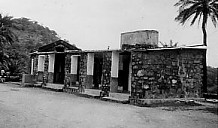 Speaking of cans, pun intended, this one's a bit earthy, and gets gut-aching squeals from our spouses and others who never experienced the joys of Abu. The bofs were an eternal point of complaint. There were 19 stalls, 1-13 English style for the smallies who used bofpape, and 14-19 Indian style for the men, who invariably used the lota (the architect was into prime numbers). Proper mugs would have been stolen promptly. So we re-used butter tins from the kitchen. They were enormous, about 20 cm in diameter and 10 cm tall. And there was no working plumbing in a stall, so you had to fill a tin in advance at the lone tap outside. When we had to go in a hurry, we relied on a good soul to fill a tin and pass it over the door. There were occasional mishaps, no, frequent mishaps, with one or both parties getting drenched. The technique was to give it a little intentional tip, not a tsunami-type splash which would come across as boorish. This has got to be the explanation for why Abuites stay good buddies 30, 40, even 60 years later. How much more intimate can you get with a friend than to fill his lota?
Speaking of cans, pun intended, this one's a bit earthy, and gets gut-aching squeals from our spouses and others who never experienced the joys of Abu. The bofs were an eternal point of complaint. There were 19 stalls, 1-13 English style for the smallies who used bofpape, and 14-19 Indian style for the men, who invariably used the lota (the architect was into prime numbers). Proper mugs would have been stolen promptly. So we re-used butter tins from the kitchen. They were enormous, about 20 cm in diameter and 10 cm tall. And there was no working plumbing in a stall, so you had to fill a tin in advance at the lone tap outside. When we had to go in a hurry, we relied on a good soul to fill a tin and pass it over the door. There were occasional mishaps, no, frequent mishaps, with one or both parties getting drenched. The technique was to give it a little intentional tip, not a tsunami-type splash which would come across as boorish. This has got to be the explanation for why Abuites stay good buddies 30, 40, even 60 years later. How much more intimate can you get with a friend than to fill his lota?
All of the above was pretty advanced compared with the early 1950s. My late cousin was at SMS then, and told me — and Datch confirms his account — that water was brought up to school by buffalo. The boys helped to carry in pipes, their reward being water on tap ever after.
Movies. We watched one almost every Sunday. A lot of John Wayne, some Laurel and Hardy. During Br O'Neill's time there were documentaries on British football: Bobby Charlton and his ilk. The projector was 16 mm. It limited our choices, but that didn't matter, I mean, what's more fun that cowboy movies? If things got romantic and concluded with a kiss, God forbid, a horrified “Aw!” would go up from the audience. The smallies would cover their eyes. The bigger chaps would only half-close theirs, hoping that a PG-rated frame or two slipped by the censors. Each movie typically came on three reels of film, so there were mandatory interruptions while reels were switched. The next best thing to commercial breaks. The problem was the periodic fits when the delicate mechanisms in the projector fell out of sync and the image shuddered. The Brother in charge would poke a finger into the machine and all would be fine. By 1973 the projector was really complaining. The Wizard of Oz was a blurred riot of colour from start to finish. Br Kelly, the tech genius who'd held the machine together for years, had left. Fr Bonaventure, perhaps an octagenarian by then, stopped to help. “It's very old,” he concluded. Wiz was the last movie in 1973.
Smallies had a way of ruining movies. Towards the end when the hero showed up to rescue the nice guys from the bad guys, the smallies would break into applause, and the big guys in the back would yell at them to shut up. It happened when I was a smallie. And it happened when I was a biggie.
Sports Day. Until 1970, the Gurkha Regiment's bagpipe band provided live music for the March Past and drills. For the marches it was Scotland the Brave, the drills ran to Skye Boat Song, and the Keel Row accompanied jogs. It must have been incongruous but delightful to an outside observer to hear Scottish music played by a Gurkha band in an Irish school in Rajasthan. It was expected that Mr Ludwig, the German-Indian bandmaster, would have the band take over at some point, but his standards were high, and over his brief 2-year stint he was not satisfied that we could handle it. In 1971 Mr Correia, working largely with Ludwig's protégés, took that plunge and the world didn't end.
